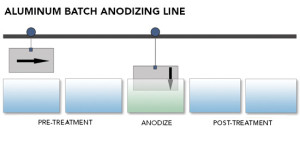Anodizing is an conversion coating of the Aluminum Surface and its alloy to porous oxide film (Al2O3). Unlike Electroplating Aluminum part to be coated becomes an anode in Electrolytic cell. Anodizing is typically and popularly associated with Aluminum but similar process is used for other base metals such as Magnesium, Titanium and Zinc.

Simple Anodizing Process Schematic
Anodizing aluminum can be accomplished in a wide variety of electrolytes, employing varying operating conditions
including concentration and composition of the electrolyte, presence of any additives, temperature, voltage, and
amperage. Depending upon the process and controlling the parameters properties of film/coating can be controlled.
Some of the typical benefits of Anodizing are:
- Increase corrosion resistance: Sealed anodic coatings of aluminum oxide are corrosion resistant and highly resistant to atmospheric and salt-water attack. The anodic coating protects the underlying metal by serving as a barrier to would-be corrosive agents. In order to achieve the optimum corrosion resistance, the amorphous aluminum oxide produced by anodizing is sealed by treating in slightly acidified hot water, boiling deionized water, a hot dichromate solution, or a nickel acetate solution.
- Improve decorative appearance: All anodic coatings are lustrous and have relatively good abrasion resistance. Therefore, these coatings are used as the final finishing treatment when the natural appearance of the aluminum is desired or when a mechanically induced pattern is to be preserved. The degree of luster of anodic coatings depends on the condition of the base metal before anodizing. Dull etching decreases luster; bright etching, chemical or electrolytic brightening, and buffing increase luster, either diffuse or specular. Most of the aluminium used in architectural applications is anodized.
- Increase abrasion resistance: The hard anodizing processes produce coatings from 25 m (1 mil) to more than 100 m (4 mils) thick. These coatings, with the inherent hardness of aluminum oxide, are thick enough for use in applications involving rotating parts where abrasion resistance is required. Although all anodic films are harder than the substrate material, the coatings produced by chromic acid and some sulfuric acid baths are too thin or too soft to meet the requirements for abrasion resistance.
- Increase paint adhesion: The tightly adhering anodic coating offers a chemically active surface for most paint systems. Anodic films produced in sulfuric acid baths are colorless and offer a base for subsequent clear finishing systems. Aluminum-base materials that are painted for service in severe corrosive environments are anodized before being painted. A fully sealed anodize may result in interior adhesion.
- Improve adhesive bonding: A thin phosphoric acid or chromic acid anodize improves bond strength and durability. Such coatings are widely employed in the airframe structure of most modern aircraft.
- Improve lubricity: A combination of hand polishing and/or honing the hard anodizing to a smoother surface before applying a polytetrafluoroethylene coating is a perfect combination with the hard anodizing.
- Provide unique, decorative colors: Colored anodic coatings are produced by different methods. Organic dyes can be absorbed in the pores of the coatings to provide a whole spectrum of colored finishes. Certain mineral pigments can be precipitated within the pores to yield a limited range of stable colors. Integral color anodizing, depending on the alloy composition, is used to provide a range of stable earth-tone colors suitable for architectural applications. Electrolytic coloring is a two-step process involving conventional anodizing followed by electrodeposition of metallic pigments in the pores of the coating to achieve a range of stable colors useful in architecture. Coloring is discussed in a subsequent section of this article.
- Provide electrical insulation: Aluminum oxide is a dielectric. The breakdown voltage of the anodic film varies from a few volts to several thousand volts, depending on the alloy and on the nature and thickness of the film. The degree of seal also affects insulation properties.
- Permit subsequent plating: The inherent porosity of certain anodic films enhances electroplating. Usually, a phosphoric acid bath is used for anodizing prior to plating.
- Detection of surface flaws: A chromic acid anodizing solution can be used as an inspection medium for the detection of fine surface cracks. When a part containing a surface flaw is removed from the anodizing bath, then washed and dried quickly, chromic acid entrapped in the flaw seeps out and stains the anodized coating in the area adjacent to the flaw.
- Increase emissivity: Anodic films more than 0.8 m (0.032 mil) thick increase the emissivity of the aluminum. When dyed black, the film has excellent heat absorption up to 230 °C (450 °F).
- Permit application of photographic and lithographic emulsions: The porosity of the anodic film offers a mechanical means of holding the emulsion.